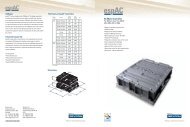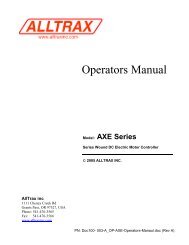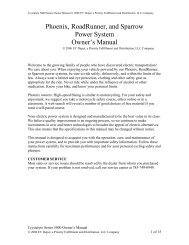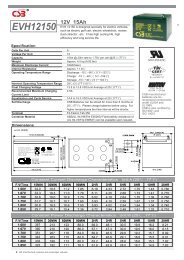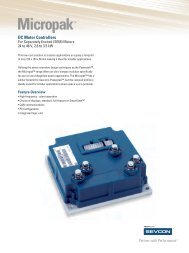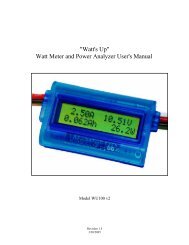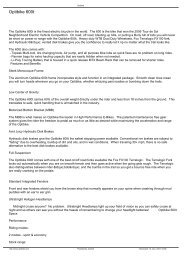Lead Acid Battery Desulfator - V is for Voltage electric vehicle forum
Lead Acid Battery Desulfator - V is for Voltage electric vehicle forum
Lead Acid Battery Desulfator - V is for Voltage electric vehicle forum
You also want an ePaper? Increase the reach of your titles
YUMPU automatically turns print PDFs into web optimized ePapers that Google loves.
<strong>Lead</strong> <strong>Acid</strong> <strong>Battery</strong> <strong>Desulfator</strong>http://www.shaka.com/~kalepa/desulf.htm3 of 5 11/26/2005 11:51 AMmost frequent questions <strong>is</strong> about the fact that the drive frequency <strong>is</strong> at 1 khz, but the resulting vibrations inthe battery are at several MHz. Go back over the part in the article about the "plucked string". Th<strong>is</strong> <strong>is</strong> a verycommon situation in all systems with a resonant frequency. A d<strong>is</strong>turbance of any sort will tend to createvibrations at the resonance. The megahertz range vibrations are over very quickly, ie they are a dampedoscillation. The pulser circuit does not drive these frequencies, any more than a finger nail drives a guitarstring at its pitch.One can see them readily using an oscill<strong>is</strong>cope, but some care <strong>is</strong> required to get the triggering just right. Abetter way to see the fact that batteries have a high frequency resonance <strong>is</strong> to use a sweep generator, as in thediagram:In the original article, I put <strong>for</strong>th an idea of what might be happening in the battery to cause th<strong>is</strong> resonantfrequency, and guessed that it was occuring in the electrolyte itself. An email from battery expert HeinzWenzl, in Germany, said th<strong>is</strong>:The next question in my quest to understand th<strong>is</strong> <strong>is</strong> the following: Given the same battery typethere are small deviations of resonant frequency which are no measurement artefact. Now undernormal conditions (i.e. the battery not being deep-deep d<strong>is</strong>charged with an acid density close toone), there are always a lot of hydrogen and sulfate ions around which can create a plasma typecharge d<strong>is</strong>tribution. A change of the frequency could be linked to the electrolyte density which <strong>is</strong>related to the state-of-charge (I have found no real correlation here), the v<strong>is</strong>cosity (th<strong>is</strong> I wouldimagine would be linked to the IR spectrum of molecular vibrations), the current exchangedensity (linked to state-of-charge and surface area and catalytic properties, etc.) and to .... someothers. But gut feeling would tell me, that all these effects should be small compared to theplasma properties themselves. In which case, all lead acid batteries with flooded electrolyteshould have the same resonance and NiCd a different one.What makes you think that the plasma condition <strong>is</strong> associated with the electrolyte and not withthe solid material? Some lead minerals, e.g. PZT are piezo<strong>electric</strong> and the few Mhz are really inthat range of effects!So my original guess about what may be going on was not very close to the mark. Nevertheless, theresonance <strong>is</strong> very much there, and it helps to create conditions of high peak voltage (ringing) that arefavorable to the process of desulfation.Does th<strong>is</strong> really work ?The results are coming in. Here are some typical comments:



